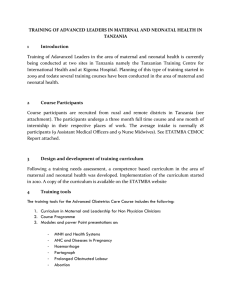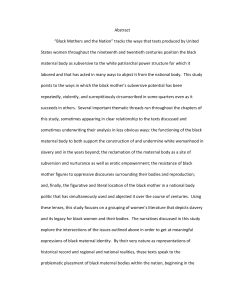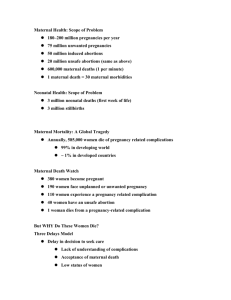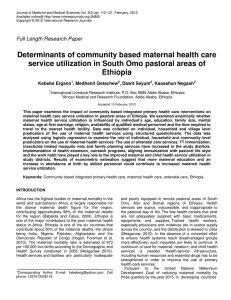ASSESSING THE MATERNAL HEALTH SITUATION
advertisement
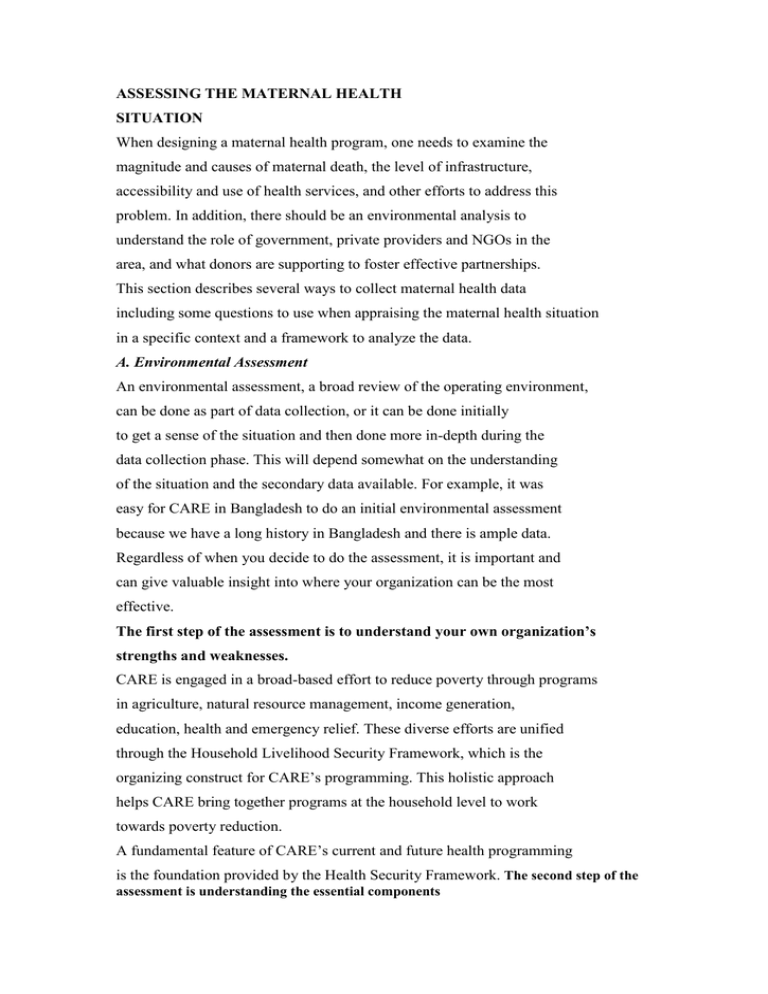
ASSESSING THE MATERNAL HEALTH SITUATION When designing a maternal health program, one needs to examine the magnitude and causes of maternal death, the level of infrastructure, accessibility and use of health services, and other efforts to address this problem. In addition, there should be an environmental analysis to understand the role of government, private providers and NGOs in the area, and what donors are supporting to foster effective partnerships. This section describes several ways to collect maternal health data including some questions to use when appraising the maternal health situation in a specific context and a framework to analyze the data. A. Environmental Assessment An environmental assessment, a broad review of the operating environment, can be done as part of data collection, or it can be done initially to get a sense of the situation and then done more in-depth during the data collection phase. This will depend somewhat on the understanding of the situation and the secondary data available. For example, it was easy for CARE in Bangladesh to do an initial environmental assessment because we have a long history in Bangladesh and there is ample data. Regardless of when you decide to do the assessment, it is important and can give valuable insight into where your organization can be the most effective. The first step of the assessment is to understand your own organization’s strengths and weaknesses. CARE is engaged in a broad-based effort to reduce poverty through programs in agriculture, natural resource management, income generation, education, health and emergency relief. These diverse efforts are unified through the Household Livelihood Security Framework, which is the organizing construct for CARE’s programming. This holistic approach helps CARE bring together programs at the household level to work towards poverty reduction. A fundamental feature of CARE’s current and future health programming is the foundation provided by the Health Security Framework. The second step of the assessment is understanding the essential components needed for effective programming. Health security is a useful framework when looking at what essential components are needed to ensure good maternal and neonatal programming. In terms of maternal and neonatal health, this means assessment of the health risk to mothers and newborns utilizing qualitative and quantitative methods. This data needs to be reviewed in terms of the following components, which we believe are essential to address the complex problems of maternal and neonatal deaths. ➔ Optimal health interventions: Experience and research tell us what are the optimal health interventions, which may be either preventive or curative, for each major cause of mortality/morbidity. For example, there have been major advances in our understanding of the role of emergency obstetrical care in maternal health. Where effective technical packages exist, then the task is to promote the use of optimal health technologies. CARE focuses much of its effort on bringing simple, effective technologies to bear. However, clear technical solutions are not always apparent; then CARE can play a useful role in testing alternatives. ➔ Healthy behaviors within the household: Many of the risks experienced by poor households can be mitigated at low cost through behavior change at the individual and household level. Maternal health outcomes could be improved dramatically through increased use of family planning, and preparing for the possibility of complications during birth. ➔ Community empowerment: Conventional approaches to improving health status have focused largely on the supply side (e.g., increasing the capacity of health providers to deliver services). Community empowerment can play a key role in behavior change and demand generation. Of particular importance is strengthening the influence of community health organizations controlled by women and focused on the health priorities of women.


